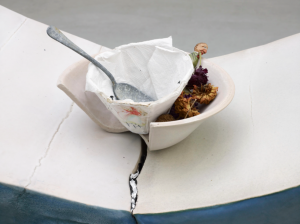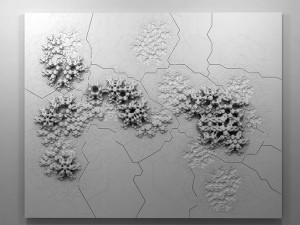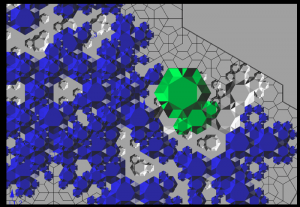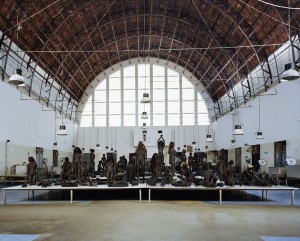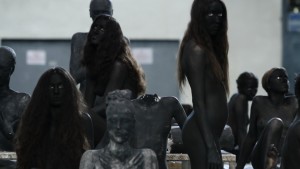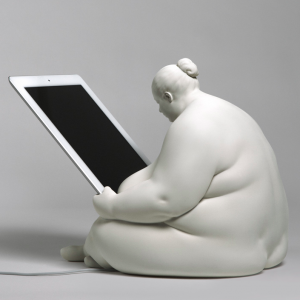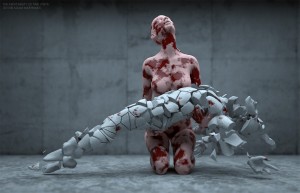Immediate Response:
This video reminded me of abstract art that doesn’t necessarily make sense as a whole, but when broken down makes more sense. The variety of clothes that were worn reminded me of the 70’s from the colors and patterns used.
I also focused on the artistic messiness that was displayed in both the clothes worn by actors and physical props. For example, I noticed how despite the appearance of nudity, the women in the beginning had applied tape to their nipples to censor them. This tape was not applied in a symmetric or thought-out method, but rather the tape seemed to be applied with little thought to its appearance and rather with a complete focus to cover the nipple. Similarly, the man in black throwing wax seemed to have some randomness or arbitrary method to how and where it was thrown.
I noticed how similar the women looked, camera shots from a distance made the distinct features of the women blur together. In contrast, all men in the video were distinct and easily distinguished. The women dancing as a group reminded me of old fashion dancing in musicals. The music that accompanied it with the saxophone also aligned itself to this older fashion feel.
Objective Description:
All actors are not making eye contact and project a stoic facial expression for all parts in space that they inhabit. Also, the way many actors were dressed did not resemble fashion that would normally be worn in other contexts. The man dressed in pink was the main character of the story and utilized largely as a method for seguing to the next scene in the video. He played the main role in the video, everything revolved around his actions and his interactions. The music aligned itself with the scene by changing its frequency and tone to instill a feeling for the scene. It was through this method of utilizing music that we came to understand how we should feel.
Technical Decisions:
The director had a purpose to each component of the video. There is a beginning and end to many of the scenes of the video. For example, the mostly nude women in the beginning of the video are shown walking back to the water later to indicate that they will be there until we are shown differently.
The man dressed in pink brings the viewer to the next scene so that the story flows together and doesn’t seem to be haphazard. The scenes shown to the viewer in which the man in the pink is not present indicate a more private occurrence. The man in the pink provides us with a feeling that now the whole audience understands.
The sound and its loudness are played with to indicate the focus of the video. Vague sound of other floors can be heard which indicates the floor’s location with respect to the other floors. The movement of people in the scenes also leads to the feeling that is instilled in the viewer. For example, the scene in which the man in pink chooses the weapons, two competing bands loudly play cacophonous music while people run around in a confusing mess that is so disorderly that it requires people with “STAFF” imprinted on their shirts to keep it under control.
The Work in the World:
The work demonstrates the common story of a man rejected by a woman. Many men lust for gorgeous women but many are also turned down. Rejection hurts and causes men to react. These men struggle to feel better. Some go through great lengths to plot revenge, doing what they can to cause damage to the woman hurt them. There are competing emotions in any decision to this degree, confusion, and lots of anger. Some times the reaction doesn’t make sense but they begin to do something to make them feel good. They can be so focused on a specific woman that hurt them that despite being comforted by other women, they still remain angry. If the hurt man does decide to try to cause harm to the woman that hurt him, then this leads to hurt for all at the end. The woman forever feels the pain and is always part of the man’s thoughts. The pain never goes away from a decision to act on revenge, it only gets worse.
The Story it Tells:
The video is led by the man in pink. The story begins with minimally clothed women to represent angels to introduce the story. The man in pink leads the viewer on an adventure through the story. The man falls in love with a beautiful woman, but hurts him represented as a leopard, when she turns him down. He escapes but is hurt. He finds a stock of material and begins to pile it up. This piling of material shows his process of developing a means to achieve revenge. The man is awarded a cloth and baby white goats for not hurting the woman and leaving her, despite his continued anger represented by her appearance as a leopard in the video. He returns to obtain the weapons where the hard rock is more evidently composed of two competing bands. These competing bands represent ferocious emotions competing, one that is good, not to use weapons, and one that is bad, to succumb and follow the desire for revenge.
The man kills the leopard, a metaphor for a woman who hurt him. The man attacks her. Dark colored, somber goats are seen at the end once the leopard woman in shape of her human self, blind and clearly very injured. She has goats on a leash only on the green fabric that is distinct from the orange fabric that represents the man in pink. She is sitting with most of her body in the green fabric and what looks like a skeleton of her past in sitting in the pink fabric that had been with. The man throwing liquid wax at the top floor keeps track of time for the video. When the liquid wax has reached the bottom, it is the end of the video.
